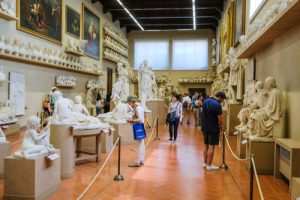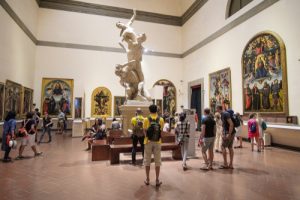The Accademia Gallery is a gallery in Florence, Italy that initially served as a place for students of the art academy to study and learn from the work of master artists. It was founded in 1784 by Pietro Leopoldo, the Grand Duke of Tuscany, and over time came to house many important works of art from the years 1200-1500. Some notable artists that populate the walls of the museum today are Giambologna, Botticelli, Monaco, and Pontormo. Today the gallery houses a wide variety of drawings, models, and paintings, namely Michaelangelo’s David, which was transported into the gallery in 1873. Over the following years, an intricate skylight was constructed by architect Emilio de Fabris which was eventually completed in 1882. The space that we now refer to as the Accademia Gallery was once the Hospital of Saint Matthew and the Convent of Saint Niccolo of Cafaggio. Later pieces added to the Galleria dell’Accademia were comprised of paintings gathered from various convents and monasteries that were being suppressed and at risk during the end of the 18th century as well as during the Napoleonic era in 1810.
Michaelangelo’s David
 Michaelangelo’s David was sculpted from a single marble block over 3 years, from 1501-1504. The state David was originally placed in the Palazzo Vecchio, but due to natural weathering of the marble and damage from rain and weather, it was moved to the interior of the gallery in 1873. The sculpture itself stands roughly 17 feet in height. Its prominent location in the town square as a piece of public art was meant to appear larger than life. Due to the previously mentioned weathering of the marble, it was restored over the period of a year during 2003-2004. It now as its own wing within the gallery called the Tribuna del David. The gallery is home to many other Michaelangelo sculptures such as the Prisoners, four incomplete pieces designed to sit in the burial area of Pope Julius II.
Michaelangelo’s David was sculpted from a single marble block over 3 years, from 1501-1504. The state David was originally placed in the Palazzo Vecchio, but due to natural weathering of the marble and damage from rain and weather, it was moved to the interior of the gallery in 1873. The sculpture itself stands roughly 17 feet in height. Its prominent location in the town square as a piece of public art was meant to appear larger than life. Due to the previously mentioned weathering of the marble, it was restored over the period of a year during 2003-2004. It now as its own wing within the gallery called the Tribuna del David. The gallery is home to many other Michaelangelo sculptures such as the Prisoners, four incomplete pieces designed to sit in the burial area of Pope Julius II.
Other works of Michaelangelo’s that make prominent features within the museum is another unfinished statue of Saint Matthew as well as a piece that some doubt can truly be attributed to Michaelangelo. The piece was discovered in 1939 inside of an inconspicuous chapel in Palestrina. The subject matter is a pietà, a common subject in Christian art that depicts the Virgin Mary embracing the slain body of Jesus. Most notably found in western sculpture during the Gothic and Renaissance periods, the name translates to lamentation in English.
If you are visiting the area and you’re looking for a Florence tour guide, we encourage you to make the trip to Accademia Gallery. If during that time you’ve been to the Piazza Della Signoria you may think that you’ve seen the sculpture, David. You’d be incorrect, however, as the statue present on the exterior of the Piazza is a replica of the state and not the original. It’s certainly worth touring the Accademia Gallery to see the true David, as there is an infinite number of intricate details and artistry that will never be present in a recreation. Namely, the sheen of the marble and detailing on the ligaments, such as subtle veins and muscles, are impossible to replicate. Additionally, the natural lighting provided by Fabris’ skylight makes for the ideal environment in which to view this masterwork.
Other Notable Works
 Other notable historic pieces located in the Accademia Gallery include Madonna and Child (Madonna col Bambino) by Botticelli as well as the painting Our Lady of the Sea (Madonna del mare). During the 1900s a new section of the gallery was formed in which rare instruments from the Cherubini Conservatory were preserved and put on display. This wing, now called the Department of Musical Instruments, houses the oldest upright piano in the world.
Other notable historic pieces located in the Accademia Gallery include Madonna and Child (Madonna col Bambino) by Botticelli as well as the painting Our Lady of the Sea (Madonna del mare). During the 1900s a new section of the gallery was formed in which rare instruments from the Cherubini Conservatory were preserved and put on display. This wing, now called the Department of Musical Instruments, houses the oldest upright piano in the world.
The gallery consists not only of works from the 13th century to the 16th century, but its also comprised of pieces from the High Renaissance as well. Most notably Giambolonga’s original preliminary work for the Rape of the Sabine Women is on display in the gallery. This gesso that acted as the outline for the final sculpture in 1582 is considered to be second only to the sculpture itself. The finished sculpture can be viewed at a nearby landmark in Florence within the Loggia dei Lanzi in the Plazza Della Signoria. In addition to other important Florentine works, the gallery does include some international influence such as a collection of Russian icons collected by some of the Grand Dukes of the House of Lorraine of which the founder Leopoldo was included.
If you’re considering visiting Florence and touring the many world-class museums available at your disposal, the Accademia Gallery is a must-see landmark with a rich history and an enormous catalog of artistic works. Another gallery you should consider visiting during your time in Florence is the Uffizi Gallery which houses works from legends like Leonardo da Vinci, Caravaggio, Titian, and Raphael as well as even more pieces by Michaelangelo. View our full tour list today to see how we can enrich your travels with our private and semi-private walking guided tours.

 Tours in English
Tours in English Tours in French
Tours in French Tours in Italian
Tours in Italian Tours in German
Tours in German Tours in Portuguese
Tours in Portuguese Tours in Dutch
Tours in Dutch Tours in Russian
Tours in Russian Tours in Portuguese
Tours in Portuguese